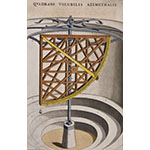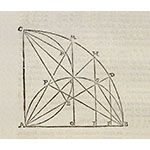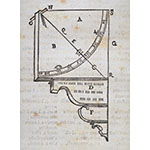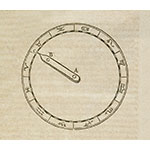The quadrant, so called because of its quarter-circle shape, may be regarded as an astrolabe folded twice on itself. This operation explains the odd appearance of the planisphere that takes up the front of the instrument. The limb (i.e., the graduated circumference) is reduced to a single 90° arc, while the sights are mounted in a fixed position on one of the straight sides. At the angle formed by the right sides hangs a plumb bob for reading the angular altitude of celestial bodies on the limb. The back generally carries the shadow square (for using the instrument in terrestrial measurements), the hour lines, and the zodiacal calendar.
Astronomical instrument with engraved markings showing the projection of the celestial coordinates. The markings are directly derived from those of the astrolabe, but are reduced and repositioned to fit inside the quarter-circle. In essence, this is an astrolabe folded twice on itself.
This category includes various types of protractors: true quadrants (90°), octants (45°), and sextants (60°), generally fitted with reduction quarters and designed to measure altitudes of celestial bodies for determining the latitude at sea. A distinctive version is the Davis quadrant. It consists of two complanar and facing octants, which measured the Sun's altitude from its reflection on a small mirror placed on the horizon plane.
Horary quadrants are engraved on one of their sides with hour lines computed for a particular latitude. Some horary quadrants had a sliding cursor that could be positioned for a specific latitude, enabling the instrument to be used for finding the time at different latitudes. A distinctive model of horary quadrant is the Stöffler quadrant, named after its inventor, Johann Stöffler (1452-1531). Its special characteristic is its "two-limbed" design, i.e., its upper and lower edges or limbs, engraved on the surface as boundaries of the hour-line sector. This feature allowed two separate readings for morning hours and afternoon hours.
This quadrant reproduces the parallel circles of a hemisphere in an orthographic projection. It was used to measure lunar distances, i.e., the distances of the Moon from the Sun, planets, and main stars. By comparing these distances with those supplied by astronomical ephemerides, one obtained, with the aid of special tables, the Greenwich meridian time at the moment of the observation. One could thus determine the longitude of the observation point.











